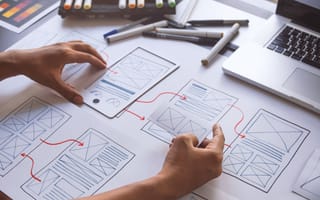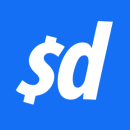In his book “The Design of Everyday Things,” Donald A. Norman, founding director of the Design Lab at University of California San Diego, says that “design is really an act of communication, which means having a deep understanding of the person with whom the designer is communicating.”
Norman was the one to coin the term “user experience” in the 1990s, and although the tech industry has exploded in recent decades, creating all manner of UX design jobs, his concepts still inform how these designers do their work: focusing on understanding and communicating with the users of a product.
Still, technology has evolved in leaps and bounds. Designers need to sharpen their technical skills, even while they maintain core commitments of communication. Built In Los Angeles sat down with two UX design leaders to hear how they’re learning and adding new skills to their design toolboxes.
Stephanie Pritchard, lead product designer at SimplePractice, found help honing her skills at several design conferences, which underscored her most valuable tools: purposeful storytelling, strategy development and framework creation.
Michael Foltzer, director of product design & creative direction at Slickdeals, implemented collaborative processes from the book “Continuous Discovery Habits” that have helped the whole company benefit from UX designers’ skills for communication.
These UX designers are using new technologies and tools to do what Norman called “the simple act of communication.”
SimplePractice helps healthcare providers manage their practice more efficiently by streamlining administrative tasks.
What technical skills — whether new or preexisting — have you acquired or sharpened in your current role? What facilitated that?
At SimplePractice, the opportunity to share work early and often has sharpened my most valuable skills as a lead product designer: purposeful storytelling, strategy development and framework creation.
When I’m given an opportunity to present my process, I make an effort to think about my audience and the story I will tell them. I develop frameworks that illuminate the ‘why’ behind my work and strategize how it fits into our larger, company-wide efforts.
When I’m given an opportunity to present my process, I make an effort to think about my audience and the story I will tell them.”
What company resources have you used to pick up new technical skills?
I’ve had the opportunity to attend design conferences, including Figma’s Config 2023, and participate in workshops like RETHINK’s “How to Develop Confidence to Influence as a Senior or Lead Product Designer.” These experiences have given me better insight into what it means to be a lead designer and helped hone my skills.
Share an example of how your sharpened technical skills have paid dividends at work. What skills did you flex and why were they central to your success?
A recent win that I can attribute to my skill development was the successful launch of our Client Portal mobile app, which is a critical communication tool for our customers and their clients. The process of designing, building and launching the app was a huge effort.
It required collaboration across multiple development teams and stakeholders, so communication was key. Storytelling our process through frameworks enabled the entire working team to remain on the same page every step of the way, which led to a faster and more successful launch.
Slickdeals is an e-commerce platform powering one of the web’s largest deal-sharing communities.
What technical skills — whether new or preexisting — have you acquired/sharpened in your current role? What facilitated that?
At many companies, design is often looked upon as a service engaged late in the process. Essentially, a product manager comes up with an idea and tells the designer, “I want you to design this.”
Most designers, however, don’t like being thrown into the process when it’s already halfway completed. Not only does it make it seem as though UX isn’t as important as it needs to be, the designer often has ideas that could improve the original concept. These would be harder to pitch and implement at a late stage in the process.
Coming up with ideas themselves, PMs are not thinking through UX/UI. This makes designers feel like they aren’t being utilized enough and that they are left out of the overall process.
Having read Continuous Discovery Habits, which talks about the foundation for product discovery and how building product features starts with the product trio of designer, product manager and engineer, I realized we could improve our process at Slickdeals. I started to research and invest team time and effort to create better and tighter collaboration to adapt design across the entire organization.
I started to research and invest team time and effort to create better and tighter collaboration to adapt design across the entire organization.”
What company resources have you used to pick up new technical skills?
COVID put a damper on overall collaboration, so I requested more in-person teamwork. The first step was to get everyone together in a physical room again. This required travel expenses for some team members, as we are geographically dispersed. Not only did it improve the collaboration, it lifted team morale.
For remote collaboration, we use FigJam for its existing starter templates, which has saved hours and hours of time that would have been spent setting up templates for our sessions.
Proper homework prior to collaboration sessions is helpful. Traditionally, brainstorms have been impromptu, but in these sessions, you only have 5-10 minutes to flush it out. We can only go so far with an idea in that amount of time. But when people take the time to do the work before the sessions, the ideas are so much stronger and well-thought-out.
We invested the time in creating an “Imagine” presentation, inviting our team to think without product or engineering limitations. We put any technology restraints aside. What would our dream scenario be to build, if we could build it and make it look any way that we want?
Share an example of how your sharpened technical skills have paid dividends at work. What skills did you flex and why were they central to your success?
The conferences in which we invested and the return to post-Covid collaboration led to the creation of an in-person collaborative design sprint in our Vegas office. This ultimately led to better collaboration and buy-in from senior leadership and our employees.
After the first design sprint, we hosted another one in our Los Angeles headquarters. Each design sprint led to the creation of our product road maps for the next 4-6 months. In the past, there would be ideation sessions between a couple of people. The organization didn’t fully grasp how important it was to have the larger team of bringing together the product managers, designers and engineers at the same time. Collaboration doesn’t truly work if these teams work in silos.
Since we’ve started working this way, we have drastically improved our collaboration across the entire organization and made folks feel more utilized and important. We’ve seen a huge increase in productivity, morale and cross-department collaboration.









